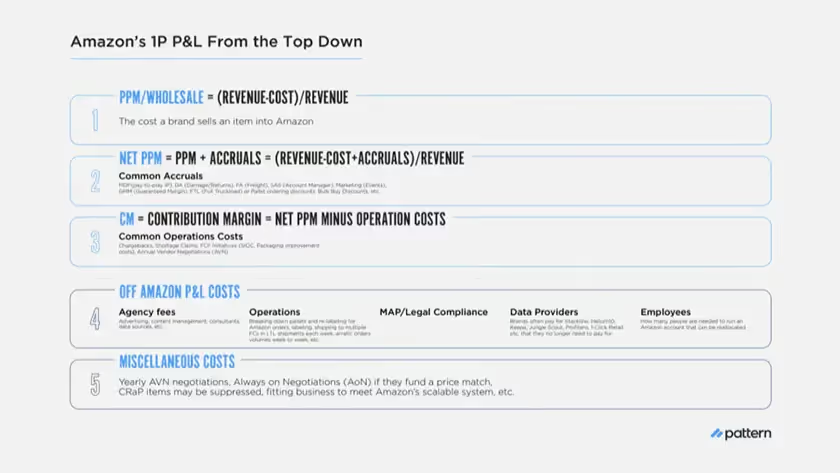Do You Know the True Costs of Amazon 1P?
Most brands struggle to identify the true costs of having a first party (or 1P) seller relationship with Amazon. Here’s how to calculate your true costs.
Most brands struggle to identify the true costs of having a first party (or 1P) seller relationship with Amazon. In brief, a 1P relationship means your brand sells your product to Amazon, who then turns around and sells your inventory on their platform. The costs of a 1P relationship can be difficult to identify, with a limited view for 1P sellers into their data on Amazon.
Learn from Doug Jensen, VP of Sales, at global ecommerce accelerator Pattern, as he explains the true costs of selling 1P on Amazon). Here’s a cheat sheet of what should be considered to calculate the true costs of being an Amazon 1P seller. The true costs of being an Amazon 1P seller, as discussed below, are based on both Amazon P&L and off Amazon P&L costs.
Amazon P&L Costs
There are three main costs included in Amazon P&L:
- PPM (Pure Product Margin)/Wholesale
- Net PPM
- Operating Margin
1. Wholesale/PPM
First is the wholesale rate (or PPM), or the cost a brand sells an item to Amazon. In a 1P seller relationship, Amazon will buy your inventory at wholesale rate. For example, if the retail price of the unit is $100, then Amazon could pay you $80 for that unit, which would be the wholesale rate.
2. Net PPM
Second, is the net PPM, or all the operational items that it takes to operate on Amazon’s platform. So, if Amazon paid you a PPM of $80 for your product unit, then they will take these operational item costs out of that $80. Here are the included operations:
- MDF (Marketing Discretionary Funds): pay-to-play 1P
- DA (Damage/Returns)
- FA (Freight)
- SAS (Strategic Account Services): A representative at Amazon who you pay for to help advocate for you on Amazon’s side, answer your questions, and be attentive to your brand.
- Marketing (Events)
- GM (Guaranteed Minimal Margin)
- FTL (Full Truckload) or Pallet ordering discounts
- Discounted Bulk Buys
If the product unit has a PPM of $80, the total of the operational items for the product unit would be $17.40, which would make the Net PPM $62.60.
3. Operating Margin
Thirdly, operating margin, or the Net PPM plus “other” operations costs. Some examples are:
- Chargebacks: if there are any issues with the products you send to Amazon, they will charge you for the time and effort it took for them to resolve those issues.
- Shortage Claims
- FCF Initiatives (SIOC, Packaging improvement costs)
- Annual Vendor Negotiations (AVN)
The total of these operations costs would be $15.20, making the total after the operating margin to be $47.40.

Off Amazon Costs
There are two main types of off Amazon costs: off Amazon P&L costs, and miscellaneous costs.
Off Amazon P&L Costs
The off Amazon P&L costs include the following:
- Agency fees: advertising, content management, consultants, data sources, etc.
- Operations: breaking down pallets and re-labeling for Amazon orders, shipping to multiple Fc’s in LTL shipments each week, erratic orders volumes week to week, etc.
- MAP/Legal Compliance
- Data Providers: brands often pay for different data providers such as Stackline, Helum10, Keepa, Jungle Scout, Profetero, 1-Click Retail, etc.
- Employees: the cost of how many people are needed to run Amazon that can be reallocated to other things.
- Internal headcount costs
- Software costs
Miscellaneous Costs
The miscellaneous costs associated with being in a 1P seller relationship with Amazon include:
- Yearly Amazon Vendor Negotiations (AVN)
- Always on Negotiations (AoN) to fund an off-Amazon price match
- Suppressed CRaP items
- Adapting your business to meet Amazon’s systems
The off Amazon P&L costs along with the miscellaneous costs, also lower the overall wholesale rate you get for the product you sold to Amazon.
1P vs 3P Seller Partner Comparison
Although the actual total costs and net profit for both Amazon 1P and 3P is about the same in the end, the 3P partner relationship is much less complicated and has fewer additional costs than 1P, such as the time and energy it takes for Yearly Amazon Vendor Negotiations (AVN) and Always on Negotiations (AoN). Pattern is the largest 3P seller on Amazon. With a 3P seller partner, like Pattern, there’s a lot less to manage and worry about, so you can easily calculate your brand’s true costs and set your company up for long-term ecommerce success.
Know Your Brand’s True Costs on Amazon With Pattern
There could be alternative models and selling strategies on Amazon to make your brand more profitable and keep your price. What each brand needs to do is first calculate your true costs as an Amazon 1P seller and discover what it costs you. We hear from most brands that partnering directly with Amazon has brands feeling overwhelmed. Without the right internal resources, the ecommerce team quickly feels incapable of tackling everything they are asked to and have to do.
As the world’s premier ecommerce accelerator, Pattern has all the resources to empower your brand with data and help you drive marketplace revenue through our ecommerce equation. We help brands avoid paying multiple agencies to deal with each area of your business such as advertising, data resources, content management, and more. Protect your brand and understand your 1P actual relationship costs with Pattern. Contact us.


.jpg)





.jpg)

